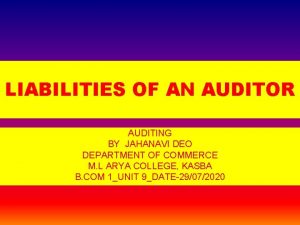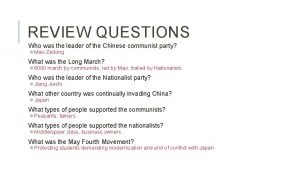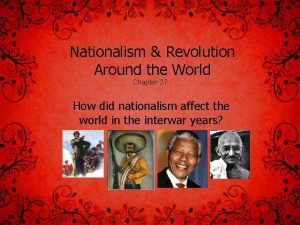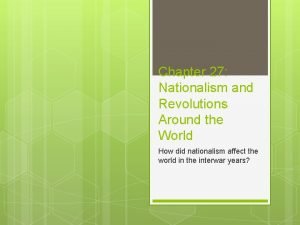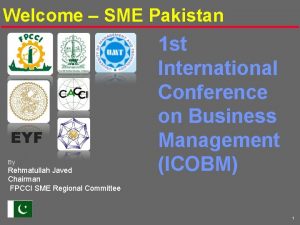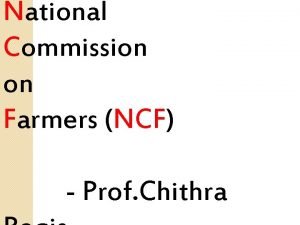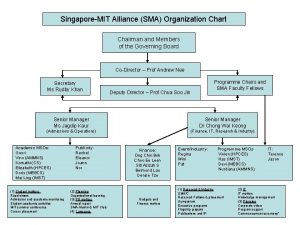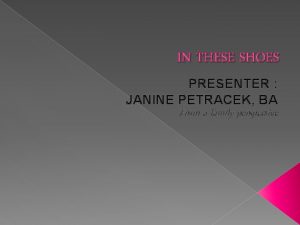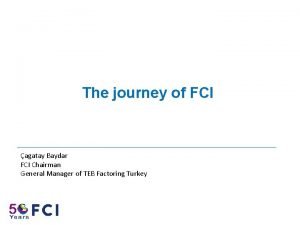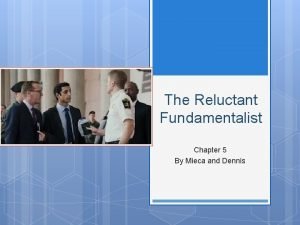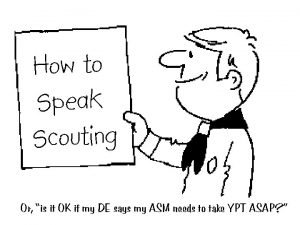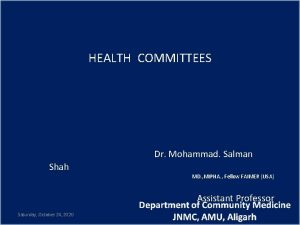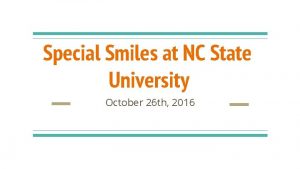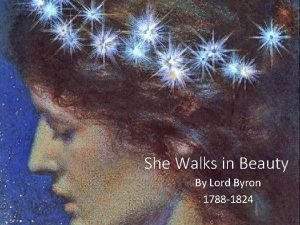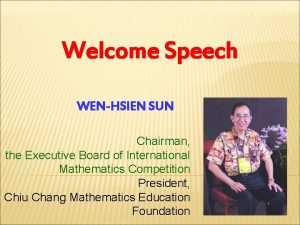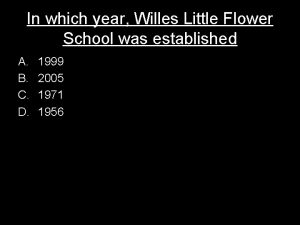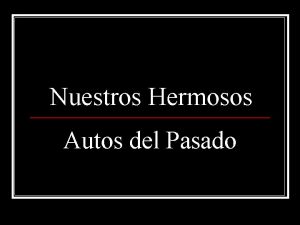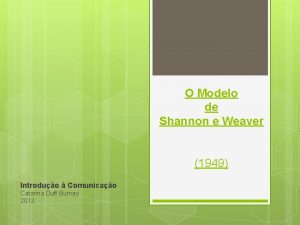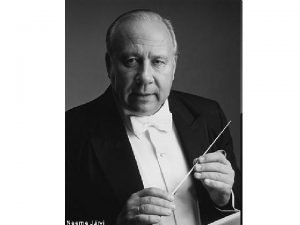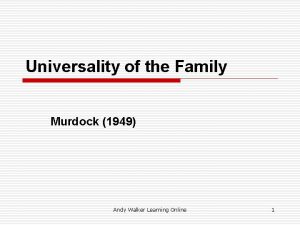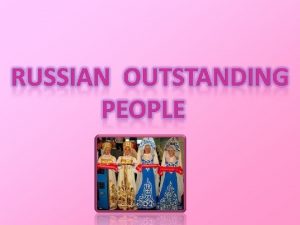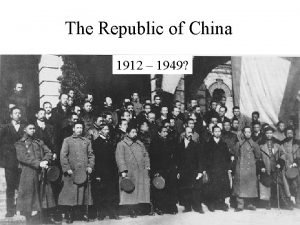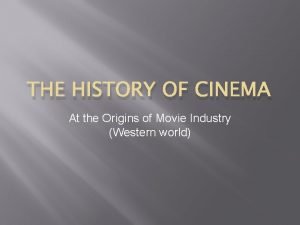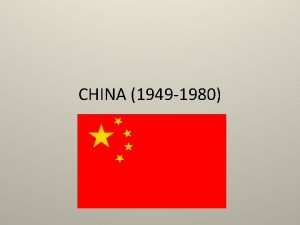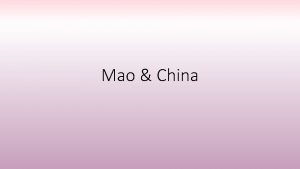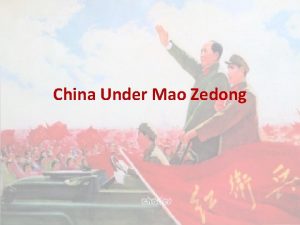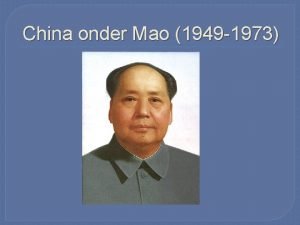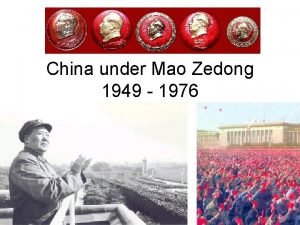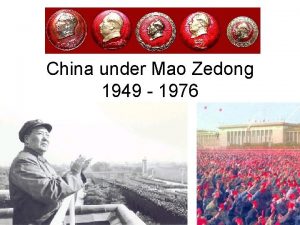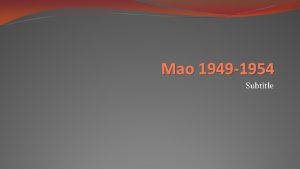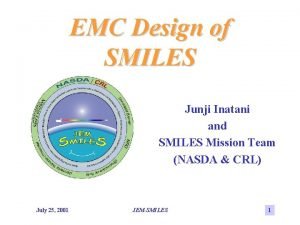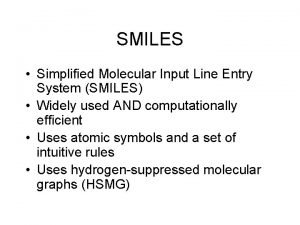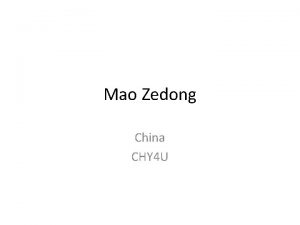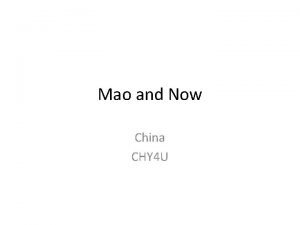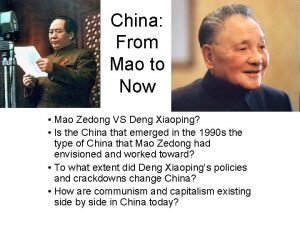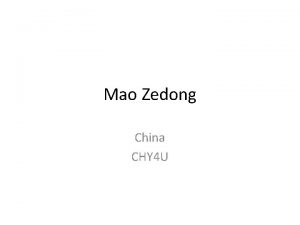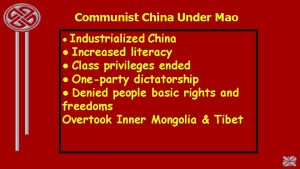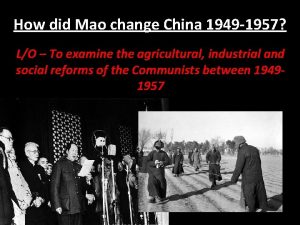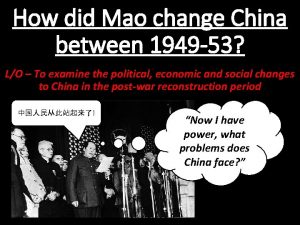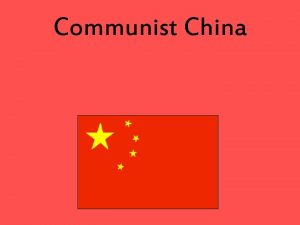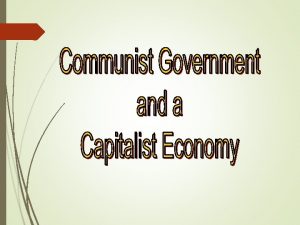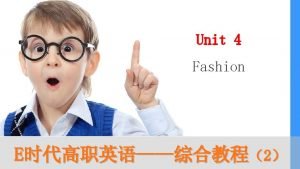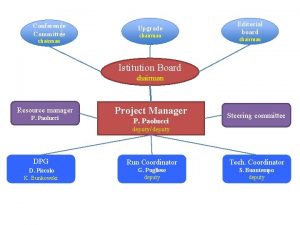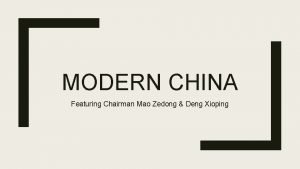China Under Mao The Chairman Smiles 1949 to









































- Slides: 41

China Under Mao The Chairman Smiles (1949 to 1976)

Mao Zedong “Report on an Investigation of the Peasant Movement in Hunan, ” (March 1927) “A revolution is not a dinner party, or writing an essay, or painting a picture, or doing embroidery; it cannot be so refined, so leisurely and gentle, so temperate, kind, courteous, restrained and magnanimous. A revolution is an insurrection, an act of violence by which one class overthrows another. ”


Chinese Civil War Nationalists vs. Communists (1946 to 1949)

Chinese Civil War (1946 to 1949) Guomingdang (GMD) Nationalist Party Jiang Jieshi (President) Chinese Communist Party (CCP) Developed on a Soviet model, model although Marxist-Leninist thought was often problematic when applied to China Mao Zedong (Leader)


Chinese Civil War (1946 to 1949) Mao Zedong paints the war as a revolution to remove “three big mountains: ” mountains Imperialism Feudalism Bureaucrat-Capitalism Creates a united front to combat GMD, primarily made up of: Urban Workers (Few) Peasants (Many)

Map of CCP Expansion during Civil War 1946 to 1950



Chinese Civil War (1946 to 1949) People’s Republic of China (PRC) established on October 1, 1949 Mao Zedong as Chairman of the CCP Government of the Republic of China (GMD) retreats to Taiwan

Mao Zedong in Beijing, 1949

Recovery and Early Socialism Defining a New China (1949 to 1956)

Recovery and Early Socialism Adoption of a Soviet model Land reform (goal of eliminating landlord class) Development of heavy industry (owned by state) Emphasis on status of women Involvement in Korean War (October 1950) First National People’s Congress in 1954 Establishes the Constitution of the PRC Zhou Enlai takes position of Premier and Foreign Minister




Constitution of the People’s Republic of China, 1954 “In the year 1949, after more than a century of heroic struggle, the Chinese people, led by the Communist Party of China, finally won their great victory in the people's revolution against imperialism, feudalism and bureaucrat-capitalism, and thereby brought to an end the history of the oppression and enslavement they had undergone for so long and founded the People's Republic of China - a people's democratic dictatorship. The system of people's democracy - the system of new democracy - of the People's Republic of China guarantees that our country can in a peaceful way eliminate exploitation and poverty and build a prosperous and happy socialist society…. ”

Rethinking the Soviet Model Marx can be Modified, Apparently (1956 to 1961)

Rethinking the Soviet Model In 1953, the population of the PRC was found to be 583 million– million a number far higher than had been anticipated. Growing concerns regarding population and the speed of economic development led to: Collectivization of farmland the creation of “People’s Communes” A series of Five Year Plans targeted to increase industrial output

Rethinking the Soviet Model Great Leap Forward (1958 to 1960) Goal to surpass the industrial output of the United States and the United Kingdom Rural industrialization and agricultural collectivization led to MASSIVE famines Death toll somewhere between 18 and 32. 5 MILLION Political component Anti-Rightist Movement Let a Hundred Flowers Bloom Sino-Soviet split (1960)






Recovery Stepping Away from the Edge (1962 to 1965)

Recovery (1962 to 1965) Growing division within the CCP Charismatic leadership (Mao Zedong) versus bureaucracy (Deng Xiaoping) Xiaoping Mao forced to the sidelines by more conservative members of the CCP Reorganization of agricultural collectivization Farmers given more say in agricultural production

Cultural Revolution Mao’s Back. (1966 to 1976)

Cultural Revolution (1966 to 1976) Resurgence of Mao Zedong’s influence within the CCP “Great Proletarian Cultural Revolution” Revolution Re-commitment to revolution and class struggle Power struggle to succeed Mao Progression: Rise and Fall of the Red Guards Rise and Fall of Lin Biao Rise and Fall of the Gang of Four

Cultural Revolution: Red Guards Purge of CCP leaders who took control following the Great Leap Forward Deng Xiaoping Purge of intellectuals Use of “re-education camps” Public shaming for the “Four Olds” Old customs Old culture Old habits Old ideas




Cultural Revolution: Lin Biao had been put forth as the possible successor to Mao Zedong In 1971, Lin allegedly tried and failed to: Assassinate Mao Flee to the Soviet Union After the alleged assassination attempt, Lin and his family reportedly attempted to escape to the USSR. Their plane crashed, killing everyone on board. Highly suspect circumstances Destruction of CCP documents relating to the incident

Cultural Revolution: Gang of Four 1972 to 1976 was marked by a power struggle inside the CCP, led by Jiang Qing (Mao’s wife) “Gang of Four” was a nickname for four radical political leaders, including Jiang, who wanted to intensify the Cultural Revolution and its associated purges Their rivals were the “moderates” of the CCP, led by Zhou Enlai

Reestablishing Diplomacy Nixon in China (1976 to 1979)

Diplomatic Breakthroughs In 1971, the People’s Republic of China replaced the representative of the Republic of China (Taiwan) at the UN In 1972, Richard Nixon became the first American president to visit the PRC since its establishment in 1949 Official US-PRC diplomatic relations resumed in 1979

Diplomatic Breakthroughs Mao Zedong and Zhou Enlai both died in 1976 The “Gang of Four” was arrested End of the Cultural Revolution Deng Xiaoping took control of the leadership of the CCP Focuses on economic modernization


 Guerra civil china 1949
Guerra civil china 1949 An auditor can be held liable under companies act 1949 for
An auditor can be held liable under companies act 1949 for Mao mao
Mao mao Nationalism and revolution around the world
Nationalism and revolution around the world When did mao take over china
When did mao take over china Chairman agenda
Chairman agenda Sme chairman
Sme chairman Caring for smiles
Caring for smiles Which is the component of agriculture renewable action plan
Which is the component of agriculture renewable action plan Chairman 25
Chairman 25 Chairman chart
Chairman chart Elizabeth petracek
Elizabeth petracek Agatay
Agatay Option volatility smile
Option volatility smile Adjectives and adverbs examples
Adjectives and adverbs examples The reluctant fundamentalist chapter 1
The reluctant fundamentalist chapter 1 Coh chairman scout
Coh chairman scout Mukherjee committee 1966
Mukherjee committee 1966 Campus smiles ncsu
Campus smiles ncsu Lord byron descendants
Lord byron descendants Takeshi uchiyamada
Takeshi uchiyamada Thy swot analizi
Thy swot analizi Welcome speech for chairman
Welcome speech for chairman Drunkard reels
Drunkard reels Willes little flower school
Willes little flower school Lic agent career growth
Lic agent career growth 1949 cadillac series 62 4 door
1949 cadillac series 62 4 door Modelo de shannon
Modelo de shannon Helilooja 1949-2001
Helilooja 1949-2001 Caricature krokodil 1949
Caricature krokodil 1949 Murdock 1949
Murdock 1949 Dr faiza asghar death
Dr faiza asghar death Alla pugacheva was born in 1949 in moscow
Alla pugacheva was born in 1949 in moscow Equity charitable trust
Equity charitable trust 1912-1949
1912-1949 Makabuluhang pagsasama ng mga tunog
Makabuluhang pagsasama ng mga tunog Arthur miller 1949
Arthur miller 1949 The ten commandments 1956
The ten commandments 1956 How was china reunited under the sui dynasty?
How was china reunited under the sui dynasty? Thứ tự các dấu thăng giáng ở hóa biểu
Thứ tự các dấu thăng giáng ở hóa biểu Vẽ hình chiếu vuông góc của vật thể sau
Vẽ hình chiếu vuông góc của vật thể sau Làm thế nào để 102-1=99
Làm thế nào để 102-1=99

